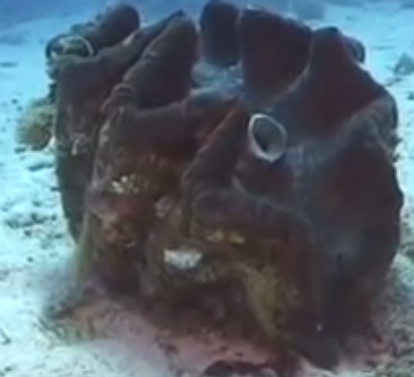You know what these are. They are steamed clams, a New England delicacy.
你知道这些是什么。它们是清蒸蛤蜊,一种新英格兰的美味。
Here in Massachusetts, we call them "steamahs" and they are delicious.
在马萨诸塞州,我们称之为“steamahs”,它们很好吃。
Compared to those little New England clams,
与这些新英格兰的小蛤蜊相比,
this ones a monster, it weighs more than a pound,
这个就是怪物,它的重量超过一磅。
But imagine clams even bigger than this.
但想象一下比这个还大的蛤蜊。
I heard about a giant killer clam, this big across!
我听说有一种杀人蛤,它有这么宽。
So I came here to an island in Micronesia, right in the middle of the Pacific Ocean.
所以我来到了这里,太平洋中央的密克罗尼西亚群岛的一个小岛上。
And I'm going to look for these killer clams.
我要去找这些杀人蛤。
The question is why do they call them killer clams?
问题是人们为什么称它们为杀人蛤呢?
Do they eat people? Do they grab you by the foot?
它们吃人吗?它们抓住你的脚了吗?
I don't know, so we're going to try and find out.
我不知道,所以我们要去尝试着找出真相。
I have come to the middle of the Pacific Ocean to find a giant clam,
我来到太平洋的中央,想找一种巨大的蛤蜊,
more specifically known as the Tridacna Clam.
更确切地说是砗磲蛤。
In the Marshall Islands, people have been eating Tridacna Clams for thousands of years.
在马绍尔群岛,人们吃砗磲蛤已经有上千年的历史了。
A mature Tridacna can feed quite a few people.
一个成熟的砗磲蛤可以供几个人吃。
Except for being a bit heavy, hunting these clams isn't very hard... it's not like they can get away.
除了有点儿重之外,猎杀这些蛤蜊并不难……它们不可能逃脱。
So they have been over-harvested in most of the Pacific, and finding them these days is not an easy task.
因此在太平洋的大部分地区,它们一直被过度捕捞,现在发现它们并不是一件易事。
I set out to a secret place in the Marshall Islands where there are supposed some giant clams.
我动身前往马绍尔群岛的一个神秘之地,那里应该有一些巨大的蛤蜊。
Well, this is the spot, so I guess now it's time to go look for some killer clams!
好了,到地方了,我想现在是时候去找一些杀人蛤了!
When I hit the water, I start to search for the clam.
我一下水就开始寻找蛤蜊。
The reef is beautiful, with healthy coral everywhere.
珊瑚礁很美丽,到处都是健康的珊瑚。
This is a perfect place for a Tridacna. All I have to do is look around.
这里对砗磲蛤来说是完美之地。我要做的就是四处寻找。

At least I see a Tridacna clam! It's grown into the reef, so it's a little hard to see.
我起码看到了一只砗磲蛤!它长在暗礁里,所以有点儿难以见到。
It responds to my hand movements.
它能对我的手势做出反应。
That's because it is sensitive to light and when my hand casts a shadow on it, the clam retracts to protect itself.
这是因为它对光很敏感,当我的手在它上面投下阴影时,它就会收缩来保护自己。
This is why people thought they were dangerous.
这就是人们以为它们危险的原因。
Could a clam this large actually grab my hand? Well, let's find out.
这个大蛤蜊真得能抓住我的手吗?好吧,让我们寻找答案。
I put my hand into the clam and it closes, but the clam can't actually close all the way.
我把手放进蛤蜊里,它合上了,但是它却不能完全闭合。
See, all my fingers are still there. So much for the killer clam.
看,我的手指还在。我的手对杀人蛤来说太大了。
Tridacna clams live in shallow, sunlit waters.
砗磲蛤生活在阳光普照的浅水里。
This is no coincidence, because they are solar-powered.
这不是巧合,因为它们靠太阳充电。
The clams have symbiotic algae in their tissue.
蛤蜊的组织中有共生藻。
The algae absorbs the energy from the sun and turns it into energy that it shares with the clam.
海藻吸收太阳能,并将其转化为能量,与蛤蜊共享。
Without the sun, and the algae to turn it into energy, the clam would die.
没有太阳,没有藻类将其转化为能量,蛤蜊就会死亡。
Clams also feed on plankton in the water.
蛤蜊也以水中的浮游生物为食。
They have two openings, called siphons.
它们有两个开口,叫做虹管。
The clam slurps up water through the incurrent siphon,
蛤蜊通过入水虹管吸水,
and filters the water through a sieve, extracting the plankton.
用滤网过滤掉水,提取浮游生物。
Then the water comes back out through the excurrent siphon.
然后水通过出水虹管回到体外。
The giant clam can filter hundreds gallons of water every day with this method.
巨大的蛤蜊用这种方法每天可以过滤几百加仑的水。
Unfortunately, there isn't much plankton in clear tropical water.
不幸的是,在清澈的热带水中没有多少浮游生物。
That's why the clams need the algae.
这就是蛤蜊需要海藻的原因。
These reefs would be teeming with giant clams except for the fact that they taste good, so they have been over fished.
要不是因为蛤蜊的味道很好,被过度捕捞,这些礁石会充满巨大的蛤蜊。
Here on the island of Kosrae, over-fishing of giant clams in the past has left the reefs depleted of these incredible animals,
在科斯雷岛,过去过度捕捞巨大蛤蜊的活动让珊瑚礁失去了这些不可思议的动物,
so the solution is a clam farm!
所以解决方法是蛤蜊养殖!
Kosrae is known for having one of the world's few Tridacna clam farms.
科斯雷岛以拥有一个世界为数不多的砗磲蛤养殖场而闻名。
Here they raise hundreds of the clams both for food, and to release into the wild.
在这里,他们饲养了数百只蛤蜊用以食用,并把它们放生到野外。
A dozen large tanks have clams of different sizes soaking up the tropical sun.
十几个大水塘养着不同大小的蛤蜊,它们沐浴在热带阳光下。
Seawater is pumped in from the ocean.
海水从海洋中泵入。
These clams make their own food from sunlight, just like plants.
这些蛤蜊利用阳光制造食物,就像植物一样。
All they need is a circulating water supply and time to grow.
它们所需的只是一个循环水供应和成长的时间。
As you might expect, they don't grow very fast.
正如你预料的,它们的生长速度并不快。
These little clams in this tank are babies by clam standards.
这些水塘里的小蛤蜊按照蛤蜊标准来说还是婴儿。
They're only two inches long and eleven months old,
它们只有两英寸长,11个月大,
but just to get an idea how long it takes one of these clams to grow, if you look at the next tank.
但如果你看下一个水塘的话,就会知道这些蛤蜊长大需要多长时间了。
This tank has maybe five pounders. And these guys .....
这个水塘的蛤蜊可能有5英镑重。这些家伙...
Oh NO! He's got me! Just kidding!
噢,不!它抓住我了!开个玩笑!
These guys are seven years old. It's pretty big.
这些蛤蜊7岁了,它很大。
But when you think about it, it takes seven years for a clam to get this big.
但是你想想,一个蛤蜊花七年才能长这么大。
You can see why if you over-fish these, it takes a long time for them to come back.
这样你就能明白为什么如果你过度捕捞,它们要花很长时间才能恢复了。
I'll put him down here.
我要把它放回去。
So if a five pound clam takes seven years to grow, we can only imagine how old this clam is.
所以如果5英镑的蛤蜊需要7年生长期,我们可以想象这个蛤蜊多大了。
This hundred-pound Tridacna might easily be more than fifty years old.
这只重达100磅的砗磲蛤很可能已经超过50岁了。
Its three feet across! Experts say that they may live for a hundred or more years.
它的宽度有三英尺!专家们说它们可能活了100多年。
So they are old clams, and they are big clams, but they're certainly not killer clams.
所以它们是老蛤蜊,大蛤蜊,但肯定不是杀人蛤。
They sit on the bottom and collect sunlight.
它们躺在池底,收集着阳光。
They're about as dangerous as sponges, but that's a story for another day.
它们就像海绵一样危险,但这又是另一回事了。


